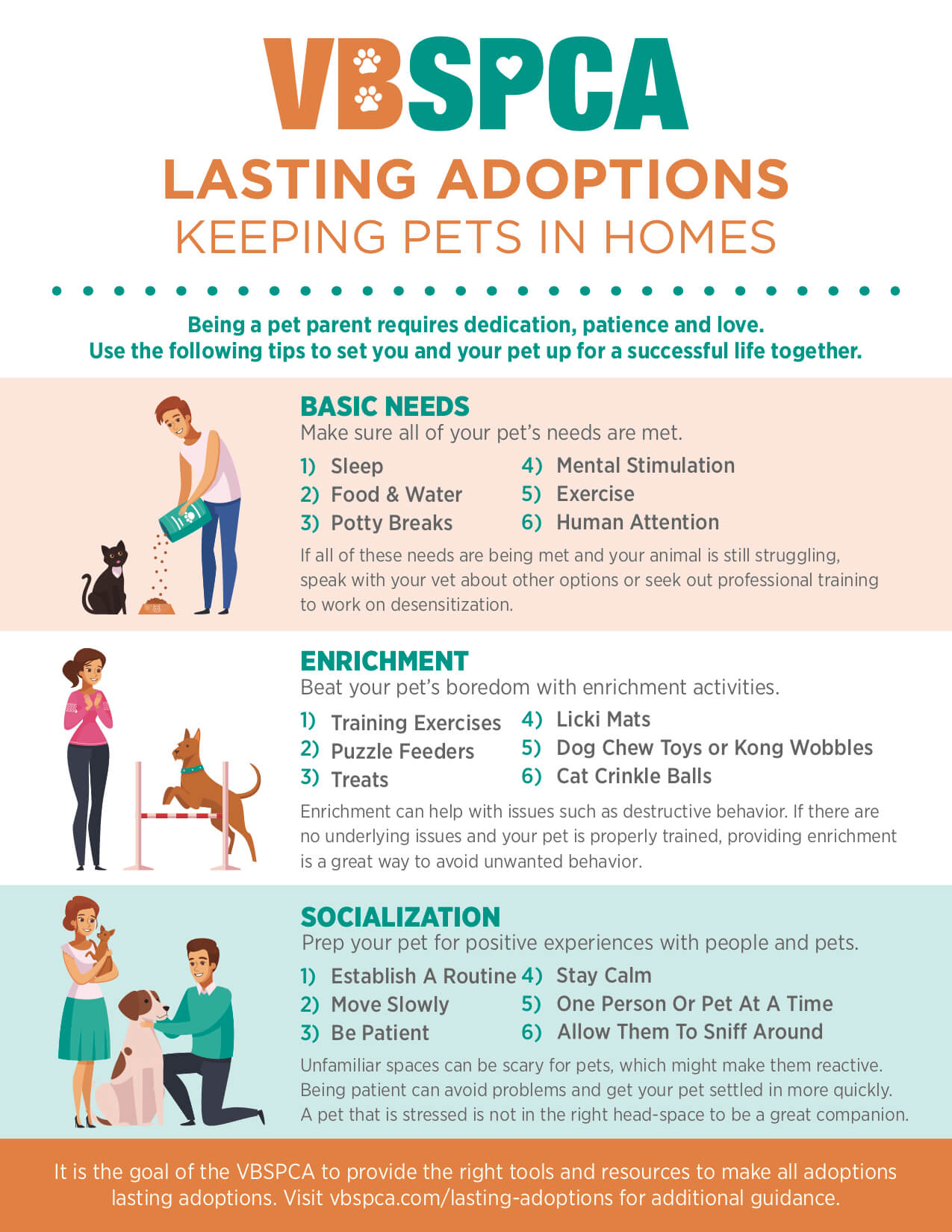Bringing a pet into the home is an exciting experience, and with it comes the hope of a long, happy life together. However, sometimes there are bumps in the road. Families adopt animals with the best of intentions, but when things get challenging at home, an animal can end up right back in the shelter. Sadly, statistics show that each time an animal returns to a shelter, the chances of adoption can decrease. It is the goal of the Virginia Beach SPCA to provide the right tools and resources to make all adoptions lasting adoptions.
The Keys to Success
Basic Needs
Make sure all of your pet’s needs are met. As with humans, our pets have basic needs that are essential to health, wellbeing, and even survival. When a need is not met, it creates an unsteady foundation upon which health and behavior issues will almost certainly arise. All pets need the following:
- Sleep
- Food & Water
- Potty Breaks
- Mental Stimulation
- Exercise
- Human Attention
If all of these needs are being met and your animal is still struggling, speak with your vet about other options or seek out professional training to work on desensitization.
Enrichment
Beat your pet’s boredom with enrichment activities. The brain is an organ that needs to be engaged and exercised. Without mental stimulation, the brain can atrophy and weaken which can lead to all kinds of behavior changes and challenges. Utilize the following activities to make sure your pet is receiving the enrichment they need. And remember, fixing an issue is always more difficult than preventing one:
- Training Exercises
- Puzzle Feeders
- Treats
- Licki Mats
- Dog Chew Toys or Kong Wobbles
- Cat Crinkle Balls
Enrichment can help with issues such as destructive behavior. If there are no underlying issues and your pet is properly trained, providing enrichment is a great way to avoid unwanted behavior.
Socialization
Prep your pet for positive experiences with people and pets. Interaction with people outside of the home is part of any pet’s life, whether it be with the mail person, the HVAC person, other dogs in a dog park, or even weekend guests. Being able to foster comfortable interactions with these unfamiliar faces is not only important for your visitors but especially critical for your pet’s nervous system. The key to comfortable interaction lies in socializing our pets early while also making sure we properly and safely introduce new spaces and faces.
When introducing your pet to something new:
- Establish a Routine
- Move Slowly
- Be Patient
- Stay Calm
- One Person or Pet at a Time
- Allow Them to Sniff Around
Unfamiliar spaces can be scary for pets, which might make them reactive. Being patient can avoid problems and get your pet settled in more quickly. A pet that is stressed is not in the right head-space to be a great companion. While you may want to automatically cuddle and love all over them, it may take a little time before they are ready, and that’s okay. For additional information on how to introduce a new pet to your home, read about introducing dogs here and introducing cats here.
Understanding the Reason Behind the Behavior
When dealing with a behavioral issue, it is important to decode what your pet is feeling. We checked in with our friend Crystal Partain, a Dog Trainer with The Freckled Paw, and she offered some great insight into our furry friends’ behavior. First and foremost, if they are acting out or showing signs of stress, there is always a reason! Consider what has happened in the recent month and answer the following questions:
- Is there any change in the animal’s routine?
- Do you suspect a medical issue to be the reason your animal’s behavior has changed? If you haven’t done so, consider taking your pet to a vet to see if there are any underlying issues.
- What is your pet’s training background? Have they had puppy obedience, basic obedience or specialized training before?
- How old is your pet? Adolescent animals are not as skilled in managing their emotions and may require a little extra patience.
There are many common issues that potentially have simple solutions.
- If your young dog is becoming reactive, be patient with them. They might simply be having big adolescent feelings about things. This is when annoying, embarrassing behaviors come into play, and they can be changed fairly quickly if caught early. If it becomes unmanageable, you can also work one-on-one with a trainer to come up with a plan. You can find our list of recommended dog trainers here.
- Pets destroying furniture and potty training issues are two of the most frustrating things pet owners have to deal with. For dogs, you can set them up for success by ensuring that they are properly crate trained and making sure the areas where they will be spending the majority of their time are free of anything you don’t want damaged. Cats have specific needs when it comes to litter boxes, and you can read more information by clicking here. They also need to be provided adequate scratching posts to discourage them from scratching on furniture. There are quite a few options at your local pet store including posts and furniture tape, both of which can be a great deterrent to unwanted scratching.
- Pets take time to get used to a new home and decompress. If you just brought home your furry friend, remember the rule of 3s. In three days, your dog or cat will have figured out where they are. In three weeks, they will have figured out your routine, and in three months, they will begin to ‘unpack their bags.’ Be understanding throughout this process!
Being a pet parent requires dedication, patience and love. If you are ready to commit to providing those three things, you are on the right track! If you are seeking additional guidance, speak with your veterinarian or contact one of our recommended professional trainers.

Last Updated: June 1, 2022 by vbspcaadmin
Last Adoptions — Keeping Pets in Homes
Bringing a pet into the home is an exciting experience, and with it comes the hope of a long, happy life together. However, sometimes there are bumps in the road. Families adopt animals with the best of intentions, but when things get challenging at home, an animal can end up right back in the shelter. Sadly, statistics show that each time an animal returns to a shelter, the chances of adoption can decrease. It is the goal of the Virginia Beach SPCA to provide the right tools and resources to make all adoptions lasting adoptions.
The Keys to Success
Basic Needs
Make sure all of your pet’s needs are met. As with humans, our pets have basic needs that are essential to health, wellbeing, and even survival. When a need is not met, it creates an unsteady foundation upon which health and behavior issues will almost certainly arise. All pets need the following:
If all of these needs are being met and your animal is still struggling, speak with your vet about other options or seek out professional training to work on desensitization.
Enrichment
Beat your pet’s boredom with enrichment activities. The brain is an organ that needs to be engaged and exercised. Without mental stimulation, the brain can atrophy and weaken which can lead to all kinds of behavior changes and challenges. Utilize the following activities to make sure your pet is receiving the enrichment they need. And remember, fixing an issue is always more difficult than preventing one:
Enrichment can help with issues such as destructive behavior. If there are no underlying issues and your pet is properly trained, providing enrichment is a great way to avoid unwanted behavior.
Socialization
Prep your pet for positive experiences with people and pets. Interaction with people outside of the home is part of any pet’s life, whether it be with the mail person, the HVAC person, other dogs in a dog park, or even weekend guests. Being able to foster comfortable interactions with these unfamiliar faces is not only important for your visitors but especially critical for your pet’s nervous system. The key to comfortable interaction lies in socializing our pets early while also making sure we properly and safely introduce new spaces and faces.
When introducing your pet to something new:
Unfamiliar spaces can be scary for pets, which might make them reactive. Being patient can avoid problems and get your pet settled in more quickly. A pet that is stressed is not in the right head-space to be a great companion. While you may want to automatically cuddle and love all over them, it may take a little time before they are ready, and that’s okay. For additional information on how to introduce a new pet to your home, read about introducing dogs here and introducing cats here.
Understanding the Reason Behind the Behavior
When dealing with a behavioral issue, it is important to decode what your pet is feeling. We checked in with our friend Crystal Partain, a Dog Trainer with The Freckled Paw, and she offered some great insight into our furry friends’ behavior. First and foremost, if they are acting out or showing signs of stress, there is always a reason! Consider what has happened in the recent month and answer the following questions:
There are many common issues that potentially have simple solutions.
Being a pet parent requires dedication, patience and love. If you are ready to commit to providing those three things, you are on the right track! If you are seeking additional guidance, speak with your veterinarian or contact one of our recommended professional trainers.
Category: VBSPCA News
Search
Recent Posts
Topics